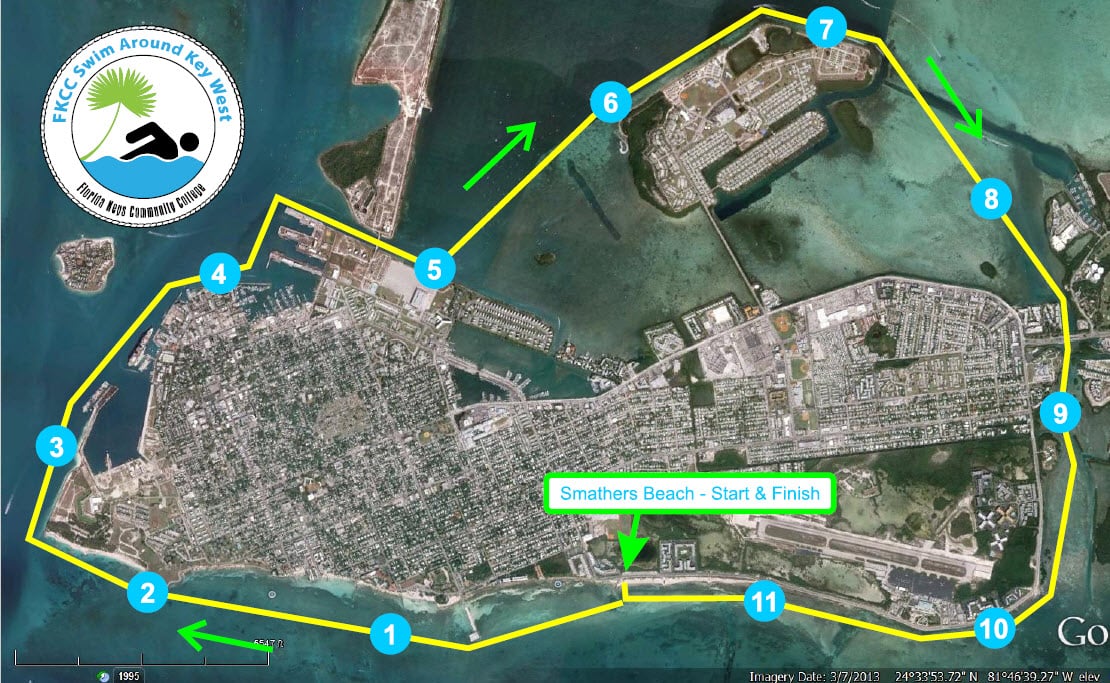The Swim Around Key West
Why Swim Around An Island?
Back in 2013 I got interested in triathlons. I thought I knew how to swim. But when I decided to hook up with swim coach Bryan Mineo and he asked me to do 25 yards. I made it only halfway across. Holding my breath. With my head up. Splashing like an injured seal. It turns out what I actually knew how to do was dive for pennies in a backyard pool.
Bryan kept at it and I kept learning. There were a lot of ungraceful 300-yard workouts at local aquatic centers. Eventually, I made it through some pool sprint triathlons, then an Olympic tri in a tiny lake nearby.
I remember telling my wife, "One day maybe I can do a half-Ironman." Two years and many, many laps later, I journeyed out to Lake Grapevine to face my fears of open water with Bryan, my new wetsuit, and other newbie open water swimmers. I eventually made it through Ironman Texas (Austin) 70.3 and finished Ironman Texas (The Woodlands) 140.6 in 2017.
Somewhere along the way, I learned to actually like what had been my weakest sport. I liked the calm, peaceful rhythms, and as someone with an engineering background, I was fascinated by the science and technique. With an Ironman behind me, I wanted to swim farther, faster, and better. I was hooked.
After finishing the Type 1 Diabetes Run Across America, a reporter for Florida Today asked me on the beach at Indiatlantic, FL what I would tackle next. At the time, I told him the truth: a shower, a nap, and a steak. (YellowDog Cafe kindly provided the steak! <3)
But as I stood staring out at the ocean, it left me thinking...why NOT do something in the ocean?
My Type 1 friend and swim mentor Karen had just completed a solo 12.5 mile Swim Around Key West, and after all the training, planning, budgeting, routing, scouting, and outfitting that went into my USA run, I wanted more than anything to do another "big" thing, but one I could train for in a season and complete in one day.
Swimming 12.5 miles isn't easy, especially balancing insulin and fueling; and just the idea of completely encircling an island that's 7 square miles blows my mind a little. I don't know if I can actually do it. But I'm determined to find out, because testing our limits is how we find out where they actually are.
12.5 miles? All at once?
I once got asked this question about my run across the US. And the answer is, I'm breaking my attempt into bite-sized pieces I know I can swallow. Baby steps first.
My ultimate goal is to complete a 12.5 mile swim around the island of Key West. I am hoping to do that in two parts:
First, in 2022, a half-distance 10K (6.2 mile) marathon swim as part of the College of the Florida Keys Open Water Swims event. This will be to establish that I can actually swim 6.2 miles in saltwater, with feeds, chop, currents, balancing blood sugars, and so on all considered.
The second part will hopefully be the full 12.5-mile distance around the island in 2023.
About the Swim Around Key West
The College of the Florida Keys Annual Swim Around Key West is one of two annual 12.5 mile swims around the island. The first ever documented swim around the island was completed by Anna Fugina in 1977 and took 13 hours. Since then, the timing has been adjusted so that tides and currents favor completing the swim in the required 8 hours.
The swim is pretty welcoming to aspiring swimmers and allows an early start for folks who feel they might need the extra time. It also allows visibility buoys, which can be useful if self-rescue is needed.
For the most part, the swim is in relatively shallow waters, with the exception of the waters on either side of Dredger's Key, a naval station connected to the main island by a causeway that prevents a shorter route around the 2.5 mi x 4 mi island.
The Route

The 12.5-mile route starts on Smathers Beach and proceeds clockwise around the island, with checkpoints near the harbor between miles 2 and 3, at Fleming Key bridge, and at Cow Key bridge. Making the checkpoints on time is critical, as the tides and currents change later in the day and make finishing difficult if you're not fast enough.
Stuff I Get Asked
Live Tracker: Key West Swim
Once June 18, 2022 rolls around, to view the GPS Tracker History for my swim at Key West, click GPS Track and filter for Custom Date Range: 06/18/2022 to 06/18/2022. To see the Race Report, click Race Report (when it's up--and it won't be until I get back from Key West!).